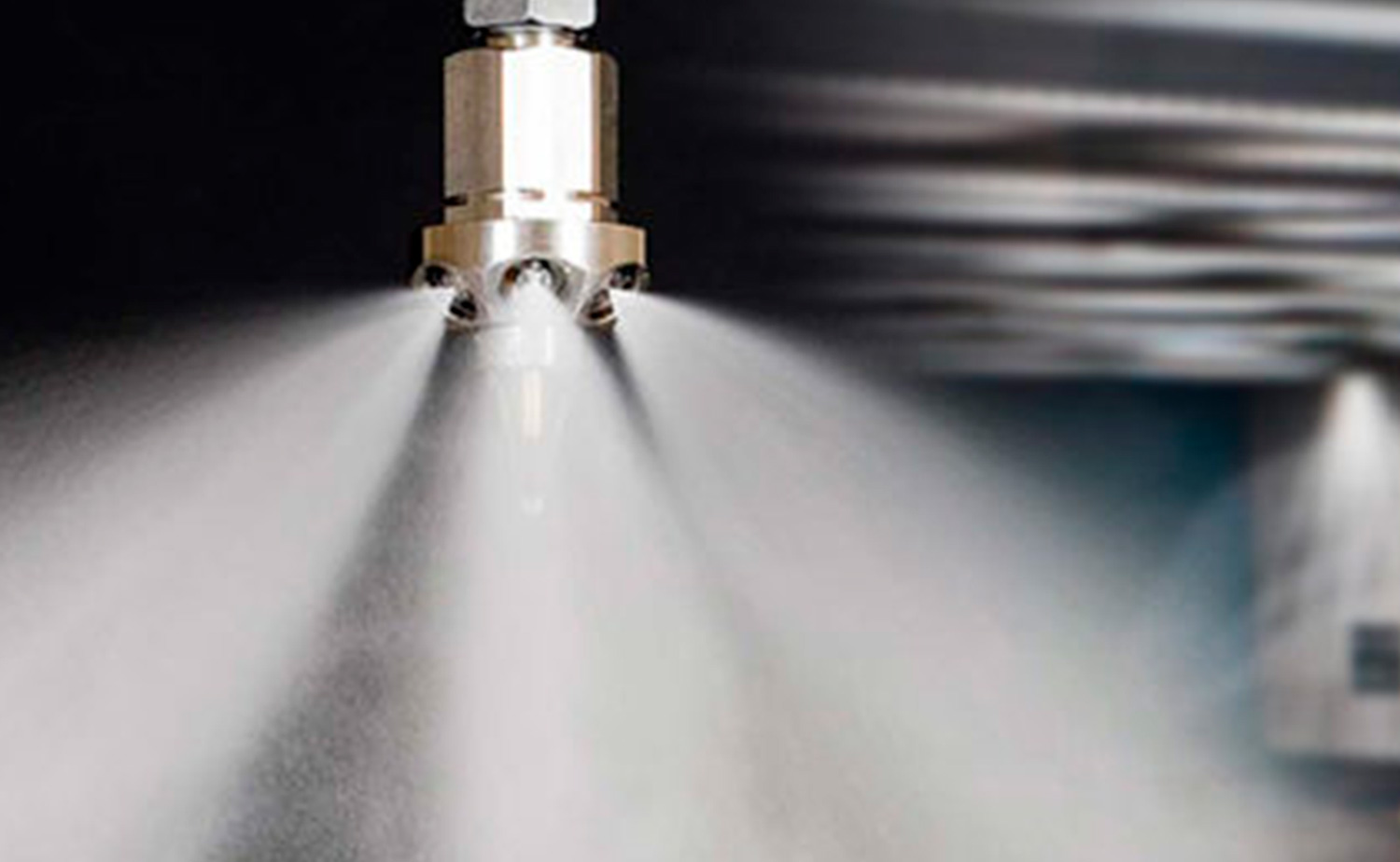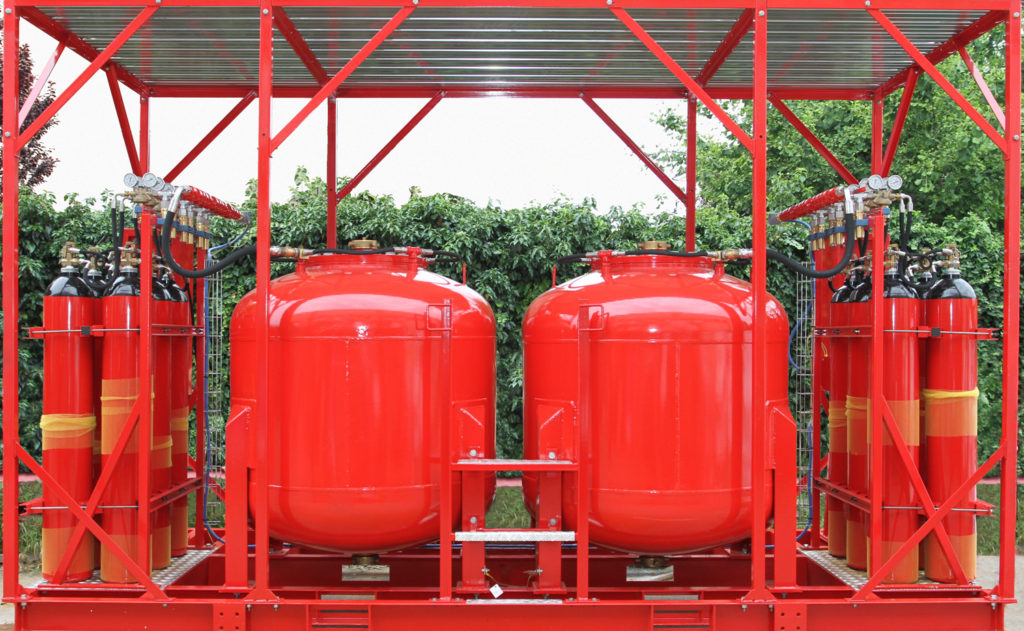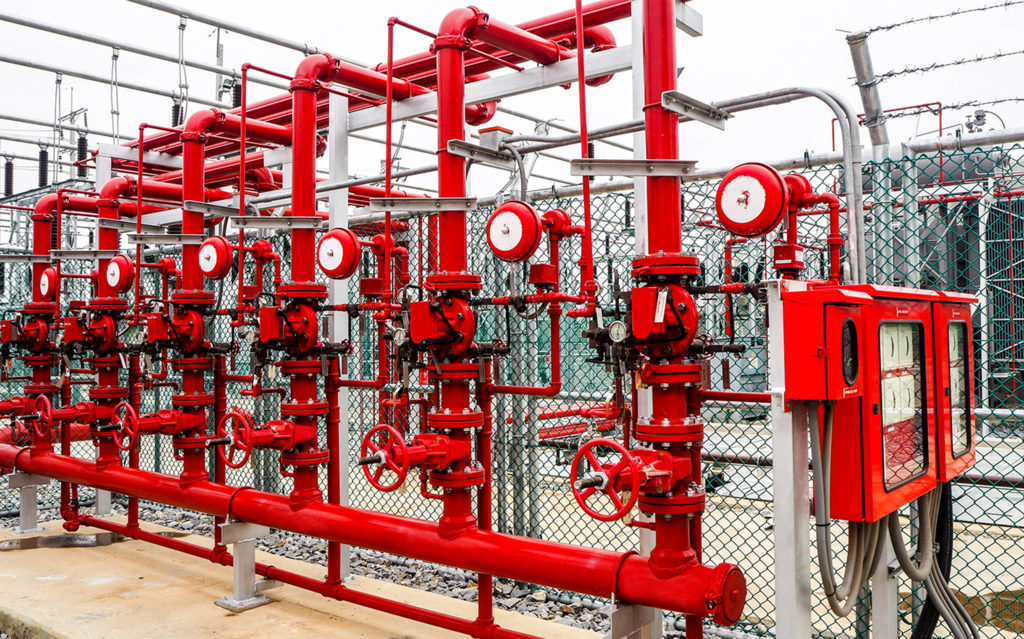Your safety partner, every day at your side.
Technological innovation, reliability and internationalization are our main assets. Thanks to the expertise acquired on the field in many years of activity, we can propose all types of firefighting solutions. Our systems undergo strict quality control procedures and our materials are tested on a periodical basis to guarantee compliance with mandatory requirements and company goals.
Sistemi Water Mist
Extinguishing agent: water mist
These automatic extinguishing systems use water mist as extinguishing agent and can be divided into three main categories:
High-pressure system with cylinders loaded with water and/or Temper and nitrogen cylinders
The water mist system is composed of cylinders filled with water and/or Temper at atmospheric pressure and of cylinders loaded with nitrogen at a pressure between 150 and 200 bar. In case of fire or in case of pressure drop in the supply pipes of the firefighting system, the (electrical or pneumatic) detection system sends a signal to the control panel to start the electrical actuators installed in the nitrogen cylinders, activating the discharge sequence. By means of a pressure reducer and a pneumatic connection circuit, nitrogen pressurizes the water storage cylinders, allowing the dispensing nozzles to discharge water mist at a pressure comprised between 75 and 85 bar;
High-pressure system with storage tank and pumps
The pressurization unit is composed of one or more high-pressure pumps actuated by electrical or diesel motors. The unit is pre-assembled in a self-standing structure made of hot galvanized steel sections and finished with weather-resistant epoxy powder paint. In case of fire, water is extracted from the storage tank and is delivered by the pumps by means of a distribution header mounted on the skid;
The system operates at low pressure (max. operating pressure is 8-10 bar) with standard pipes for longer protection.Low-pressure system with storage tank and cylinders filled with nitrogen

Sistemi Gas Inerti
extinguishing agent: oxygen reduction
These systems will fight fire by reducing the oxygen concentration. The quantity of oxygen is lowered to such a level that fire is extinguished. Inert gases are not toxic for the human body, even at concentrations capable of extinguishing the fire. In order to extinguish the fire and permit the human presence in the protected space, the oxygen concentration must be comprised between 15% and 12%. Discharge delay devices must be used when the oxygen concentration is comprised between 12% and 10%.
These systems are mainly used for protection:
– against risks from electrical equipment (data processing centers, control rooms, etc.);
– against risks from flammable liquids and combustible gases;
– of assets with high historical, artistic and cultural value (museums, libraries)
Because of a high compressibility coefficient, they can be applied in all areas where the space for gas storage cylinders (on self-standing skid or cabinet) is very limited.
Sistemi Co2
extinguishing agent: carbon dioxide
These systems use carbon dioxide as extinguishing agent. Carbon dioxide is a colorless, odorless gas that is converted in white steam when it is used to extinguish fire. The extinguishing principle is based on reducing the oxygen to such a level that the combustion process is no longer supported. Moreover, the rapid vaporization causes a considerable drop in temperature, increasing the extinguishing action of CO2. Carbon dioxide does not damage materials in case of contact, does not form decomposition substances and has excellent dielectric characteristics.
Sistemi a Gas Chimici
extinguishing agent: FK-5-1-12 gas
These systems use FK-5-1-12 gas as extinguishing agent. FK-5-1-12 belongs to the family of chemical gases that interrupt the chemical reactions of combustion, reducing heat with a higher speed compared to the heat developed by fire. The FK-5-1-12 systems achieve their extinguishing effect with a lower project concentration than the extinguishing systems with inert gas. Therefore, in case of fire, the amount of extinguishing agent introduced in the area to be protected and the duration of the discharge are lower. The gas does not leave any residues after discharge. Its non-corrosive and non-conductive properties make it perfect for the protection of electronic devices, sensitive equipment and valuable objects.
Moreover, it has an excellent safety coefficient in the project concentration. For this reason, applications are especially useful for areas with the presence of people and an intense human activity.
Emergency Pressurization Systems
breathable air from an independent source
Emergency pressurization systems are designed to guarantee the health and safety of people in emergency situations. The system is composed of cylinders with 100% reserve, pipes, fittings, instruments and reduction units to provide the breathable air that is necessary for the survival of people exposed to a serious accident, which may include explosions, hazardous fumes or toxic gas leaks.
Breathable air from a source that is independent from the environmental atmosphere is the best safety solution in extreme environments and critical conditions.
Powder Systems
Extinguishing agent: chemical powder
Chemical powder is a very versatile extinguishing agent and can be used with class A, B, C and D fires that involve combustible materials of different kind (paper, plastics, wood, metals, flammable liquids, live electrical equipment).
For each fuel category, the most suitable type of powder must be applied to guarantee the extinguishing function at best.
Generally speaking, powders are a mix of sodium bicarbonate, potassium bicarbonate or mono-ammonium phosphate with additives that improve storage attitude, water repellency and mobility.
The extinguishing principle is characterized by the interruption of the chain reaction in the combustion area: the powder will decompose in contact with the flames, absorbing heat in the decomposition and generating the formation of gaseous substances with a smothering action.
The rapid elimination of flames, the absence of toxic effects and the electrical non-conductivity favor the use of powder systems in industrial processes and firefighting vehicles.
Powder systems are generally composed of three main elements:
-
stock and storage of the extinguishing agent, which consists in a steel tank that is suitably dimensioned to contain the amount of powder that is necessary to extinguish the fire.
-
pressurization system, which consists in one or more cylinders loaded with nitrogen or carbon dioxide and connected to the reserve by means of a pressure-reduction unit
-
delivery system, which consists in fixed or portable devices.
In fixed systems, the powder is delivered by means of nozzles or monitors that surround the equipment to be protected. In mobile systems, the powder is discharged by means of hose reels connected to manual nozzles.
Powder systems may be actuated by a fire detection system or manually in case of need. They can be configured with directional valves in case of multiple protections.
The reference standards for powder systems are EN 615, EN 12416, NFPA 17 and the dimensions of a system must take into account the following parameters:
- risk classification and identification of flammable fuel (solid, liquid or gaseous)
- type of protected equipment
- type of protection (indoor space, delimited object, localized risk, outdoor object) with possibility of choosing one of the following options:
Total Flooding: the amount of extinguishing powder is calculated by applying a coefficient of discharge to the gross volume of the protected space.
Local Application: the amount of extinguishing powder is calculated to extinguish superficial fires with localized fire risk

Water Systems
customized firefighting solutions
- Firefighting pumping stations inside a container
The pumping station is the most important element of every water firefighting system and is indispensable to guarantee the correct operation of the fixed systems (sprinklers, hydrants) connected to it.
The reliability and the efficiency of a pressurization unit are crucial to guarantee the protection against all risks with the correct flow rate and discharge head values.
World Fire Systems designs and builds container solutions capable of optimizing the management of space and facilitate the building works to be carried out on the site
- Sprinkler Systems
- Flooding systems

Foam Solutions
customized firefighting solutions
- Foam-water sprinkler systems and foam-water flooding systems.
- Vertical and horizontal tanks with displacement of liquids
- Foam-water monitors
- Equipment with low, medium and high-expansion foam.
- Foam mobile units
Firefighting materials and equipmentx
firefighting equipment
- Hydrants;
- Boxes and cabinets;
- Hose reels;
- Portable and wheeled extinguishers;
- Emergency showers and eye-bath systems;
- Breathing apparatuses;
- Fire shields;
- Fire proximity suits

